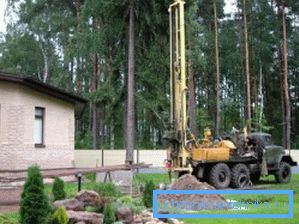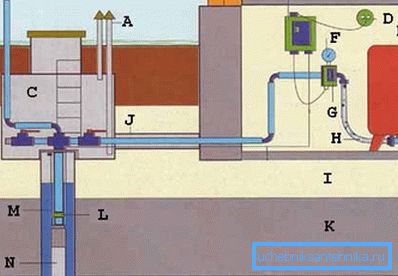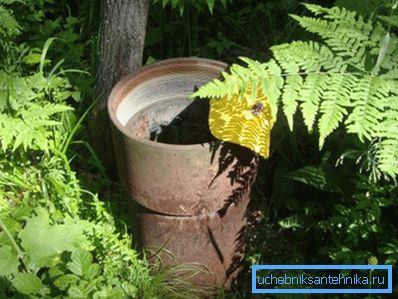Well passport is a serious document for serious work.
Of course, if you are lucky, and a sufficient layer of water is in your area at a depth of two meters, then you can invite your neighbor with the spindle and have a source at your disposal. But even this is fraught with such unforeseen difficulties of reservoir behavior, with such concerns about water quality, that somehow no one doubts that a well passport to water is not an empty formality.
If we turn to the full scheme of supplying a residential house with water from a well, then the need for contacts with professional regulatory organizations will become all the more understandable.

Official design in order to avoid big problems

A complete scheme is as follows:
- A- vent outlet;
- B - control panel;
- C - the so-called caisson - to accommodate all drilling equipment;
- D - power is supplied from a normal network of 220 V;
- E - water collection tank at the top; membrane type is recommended;
- F - pressure gauge, a mandatory tool for monitoring pressure in the system;
- G - pressure switch - for quick response to pressure surges;
- H - flexible water inlet hose;
- I - sand (if, of course, you were lucky with such a simple ground);
- J - pipeline protection case;
- K - clay;
- L - check valve;
- M - safety cable;
- N - pump - the most important element of the entire system;
- P - limestone.

Previous work
Therefore, it is not surprising that every well owner should have a passport for it.
But its design is preceded by several very important and documented steps:
- First, before starting, it is necessary to develop and coordinate a project for drilling with Rospotrebnadzor and to issue a license not to use subsoil.
- Secondly, the site on which all the work is carried out should be included in the master plan of the house, and also be described in the draft of the water intake station.
- Thirdly, a specific drilling site is determined, which is formalized in the act of laying the well and is signed by the contractor and the customer.
- Fourthly, the well is being drilled, and, each achieved action must also be supported by documents:
- act on the descent of columns;
- act on the cementation of the column.
- Fifthly, when the well is drilled, but not equipped with a filter column, it is necessary to conduct geophysical studies to clarify all previous studies and actions. The ultimate goal of these actions will be to determine the working area of the filter column.
- Sixth, further, after the well filter column is lowered, an act is drawn up for this operation, and the actual well data is entered into its passport.
- Seventh, test pumping is carried out, the results of which — water quality and productivity — are recorded in a log.
- The eighth action leads to the installation of an already operational pump and work with it for 3-5 days. The result is also a document - an act on the descent of the pump indicating its data, pipes for lifting water and the results of the reconciliation of calculated and real data.
- At this point, the passport must be completed and prepared in 3 copies.
- The final documents are the act of acceptance of the well for commissioning and its registration with the RosGeofond, the well should be assigned a state water cadastre number.
- Already during operation, the well owner, together with the sanitary control authority, is developing a water quality control program.
- All further work is carried out in accordance with the issued license for subsoil use.

Passport
In fact, once and for all approved form of a passport to the well does not exist. Its appearance may differ slightly in different regions, but the basic parameters remain the same in any case.
Basic passport data
Any sample passport to the well contains the following basic data:
- First, of course, the well number assigned by the state water cadastre.
- Further, the exact geographical location of the well is entered in the passport, starting from the republic, region, and ending with the specific address of the house.
- The postal address of the well owner is also indicated.
- Moreover, the well’s geographical coordinates (longitude and latitude) must also be entered in the passport.
- Among other information:
- the scale of the administrative map on which the longitude and latitude were determined;
- absolute wellhead elevation;
- purpose of the well and mark its use;
- The figure and the license number for the use of the subsoil with the date of issue are required.

Additional data
In addition to the main ones, a lot of additional data describing the operation of the well are recorded in the passport:
- when drilling was done and in what way;
- which drilling organization drilled;
- when and by whom the acceptance report was completed;
- design and actual data for the drilled well;
- if in the course of work there were deviations from the previously accepted project assignment, then this should also be reflected in the passport;
- in the document it is necessary to describe in detail the rocks passed in the process of work;
- The actual well design is described:
- diameters of all columns;
- filter column data;
- filter design;
- data on cementation and plugging;
- test run results;
- geophysical research;
- the results of the pilot pumping;
- chemical analysis of water;
- microbiological analysis of water;
- conclusion about water quality.
Besides:
- additional data about the well should be entered into the passport;
- indication of sanitary protection zones.
A passport must be accompanied by a series of applications that are compiled as the facility is commissioned.

Helpful advice! Looking at the above list, we do not recommend panicking and refusing the planned work or, even worse, doing all the work “in the dark”. Too this is a serious matter - drilling water wells. But, in order to somehow facilitate all paper work, contact better to specialized geophysical enterprises that are able to perform all turnkey works with the provision of a complete set of all necessary documentation.
findings
Be sure to compile a list of all the necessary documents for the official registration of all the work. Check out the additional video in this article, which will help you not to get lost in this pile of information, for neglect of which you can pay a rather expensive price.